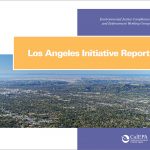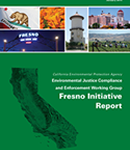The Environmental Justice Task Force coordinates the compliance and enforcement work of CalEPA’s boards, departments and office in areas of California that are burdened by multiple sources of pollution and are disproportionately vulnerable to its effects. The Task Force’s mission is to facilitate the use of environmental justice considerations in compliance and enforcement programs and enhance communications with community members to maximize benefits in disproportionately impacted areas.
Originally known as the Environmental Justice Compliance and Enforcement Working Group, the Task Force has conducted separate initiatives in parts of Fresno and Los Angeles with the goal of increasing compliance with environmental laws in these areas. These initiatives demonstrated the value of an approach that combines community consultation with compliance assistance for regulated businesses and coordinated, multi-agency enforcement sweeps to address environmental concerns. Detailed reports on these initiatives are available below.
In 2016, the success of these pilot initiatives helped to earn the Task Force permanent funding through the 2016 Budget Act. The law created a mandate for CalEPA to continue its multi-agency compliance and enforcement approach and to give priority to disadvantaged communities. The funding will ensure that the Task Force develops new initiatives in areas where increased compliance has the potential to have the greatest impact.
For more detail about the Task Forces’s mission and goals, see the policy creating the Working Group and the Working Group’s Charter (PDF).
Primary Goals
- Increase compliance in areas disproportionately impacted by health and environmental factors to prevent and reduce burdens on those communities by targeting compliance assistance and enforcement in those areas.
- Identify disproportionately impacted areas for targeted compliance assistance and enforcement efforts using the California Communities Environmental Health Screening Tool (CalEnviroScreen) and other data sources.
- Provide communities with meaningful opportunities for input on potential environmental justice concerns and the implementation of proposed remedies.
- Increase coordination among CalEPA boards and departments and with local, state, and federal regulatory and law enforcement agencies to facilitate compliance and enforcement efforts across all media (air, water, toxics, solid waste, and pesticides) in disproportionately impacted areas.
Members and Advisory Members
- California Environmental Protection Agency
- California Air Resources Board
- Department of Toxic Substances Control
- State Water Resources Control Board
- Department of Pesticide Regulation
- CalRecycle
- Office of Environmental Health Hazard Assessment
- California Air Pollution Control Officers Association
- California Conference of Directors of Environmental Health
- California Agricultural Commissioners and Sealers Association
- Certified Unified Program Agencies (CUPA) Forum Board
- Local Enforcement Agencies
 Initiative: Oakland
Initiative: Oakland
In 2016-2017, the Task Force conducted an initiative focused on the communities and East and West Oakland. Both communities are overburdened by multiple sources of pollution and high rates of childhood asthma, according to CalEnviroScreen. For an overview of this initiative, please see the Oakland Initiative Report (PDF, 4MB).
 Initiative: Los Angeles
Initiative: Los Angeles
In 2015-2016, the Task Force conducted an initiative focused on the Los Angeles communities of Boyle Heights and Pacoima. Both communities are among the top 5 percent of disadvantaged communities in California, according to CalEnviroScreen. For an overview of this initiative, please see the Los Angeles Initiative Report (PDF, 6MB).
 Initiative: Fresno
Initiative: Fresno
In 2013-2014, the Task Force selected a portion of the city of Fresno and its surrounding unincorporated area for its first initiative, with the goal of increasing compliance with environmental laws in this area. For an overview of this pilot initiative, see the Fresno Initiative Report (PDF, 12MB).

